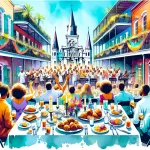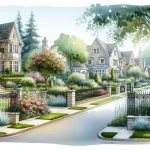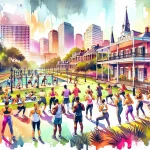Faubourg Marigny, a bohemian neighborhood in New Orleans, captures the city’s unique spirit. Colorful Creole cottages, a thriving arts scene, and an eclectic mix of restaurants and music venues offer visitors a glimpse into the soul of New Orleans.
In This Article
TL;DR
- Faubourg Marigny showcases distinctive architecture, a vibrant music and arts community, and a bohemian atmosphere.
- Iconic venues like The Spotted Cat Music Club and d.b.a. complement the lively culinary offerings and signature dishes.
- Public spaces like Washington Square host community events, concerts, and art markets, contributing to the neighborhood’s spirited ambiance.
Historical Overview of Faubourg Marigny
Origin and development: Founding by Bernard de Marigny in the early 19th century
Faubourg Marigny’s story begins in 1805 when Bernard Xavier Philippe de Marigny de Mandeville, a wealthy Creole plantation owner, decided to subdivide his land downriver from the French Quarter. This new neighborhood, named after its founder, quickly attracted a diverse population, including Creoles, free people of color, and immigrants from Europe and the Caribbean.
Architectural evolution: Transition from Creole cottages to modern influences
The neighborhood’s architectural landscape is a testament to its rich history. The early 19th century saw the construction of classic Creole cottages, characterized by their steep roofs, dormers, and generous front porches. As the neighborhood evolved, Victorian mansions and shotgun houses began to appear, adding to the area’s unique charm. Today, Faubourg Marigny showcases a mix of architectural styles, from the historic to the modern.
Role in New Orleans history: From a plantation to a vibrant urban neighborhood
Throughout its history, Faubourg Marigny has played a significant role in shaping New Orleans‘ cultural identity. The neighborhood served as a melting pot for various ethnicities and social classes, fostering a spirit of diversity and inclusivity that continues to define the area today.
Cultural Tapestry of Faubourg Marigny
Music and arts scene: Influence of jazz and local artists
Faubourg Marigny is renowned for its thriving music and arts scene. The neighborhood has been a hotbed for jazz music since the early 20th century, with legendary musicians like Jelly Roll Morton and Sidney Bechet once calling it home. Today, venues like The Spotted Cat Music Club (623 Frenchmen St, New Orleans, LA 70116, (504) 943-3887) and d.b.a. (618 Frenchmen St, New Orleans, LA 70116, (504) 942-3731) keep the jazz tradition alive, offering live performances every night.
The neighborhood also boasts a vibrant visual arts community, with numerous galleries showcasing the work of local artists. The Frenchmen Art Market (619 Frenchmen St, New Orleans, LA 70116, open daily from 7 PM to 1 AM) is a must-visit for art enthusiasts, featuring an eclectic mix of paintings, sculptures, and handcrafted items.
Festivals and events: Highlighting annual gatherings like the Jazz Fest Fringe
Faubourg Marigny hosts several annual festivals and events that celebrate the neighborhood’s unique culture. The Jazz Fest Fringe, held in conjunction with the New Orleans Jazz & Heritage Festival, features a series of intimate performances in various venues throughout the neighborhood. The Marigny Opera House (725 St Ferdinand St, New Orleans, LA 70117, (504) 948-9998) serves as a hub for the festival, offering a diverse lineup of jazz, classical, and contemporary music.
Notable residents: Impact of figures such as musicians and artists on the neighborhood’s culture
Over the years, Faubourg Marigny has been home to numerous notable figures who have contributed to the neighborhood’s rich cultural tapestry. Jazz pioneers like Jelly Roll Morton and Sidney Bechet once lived and performed in the area, while contemporary artists like James Michalopoulos and George Rodrigue have drawn inspiration from the neighborhood’s vibrant atmosphere.
Architectural Highlights
Distinctive architectural styles: Examination of Creole cottages, shotguns, and Victorian homes
Faubourg Marigny’s architectural landscape is a visual feast, showcasing a variety of styles that reflect the neighborhood’s history. Creole cottages, with their steeply pitched roofs and generous front porches, are a defining feature of the area. Shotgun houses, named for their narrow, elongated layout, are another common sight, often adorned with intricate ironwork and bright colors.
Victorian mansions, built during the late 19th century, add a touch of grandeur to the neighborhood. These elegant homes feature elaborate ornamentation, such as turrets, gables, and wraparound porches.
Preservation efforts: Role of local organizations in maintaining the neighborhood’s historical integrity
Preserving Faubourg Marigny’s architectural heritage is a top priority for local organizations like the Faubourg Marigny Improvement Association (FMIA). The FMIA works to protect the neighborhood’s historic buildings and advocate for responsible development that respects the area’s unique character.
The New Orleans Historic District Landmarks Commission (HDLC) also plays a crucial role in safeguarding Faubourg Marigny’s architectural integrity. The HDLC oversees the neighborhood’s historic district status, ensuring that any renovations or new construction adhere to strict guidelines that maintain the area’s distinctive charm.
Comparison with other New Orleans neighborhoods: Architectural contrasts with the Garden District and French Quarter
While Faubourg Marigny shares some architectural similarities with the nearby French Quarter, such as Creole cottages and colorful facades, it has a more relaxed, residential feel. The neighborhood’s streets are narrower and less crowded than those of the French Quarter, allowing visitors to appreciate the architecture at a more leisurely pace.
In contrast, the Garden District, located uptown, is known for its grand antebellum mansions and lush gardens. While both neighborhoods showcase historic architecture, Faubourg Marigny’s more modest homes and bohemian vibe set it apart from the Garden District’s stately elegance.
Modern-Day Faubourg Marigny
Demographic and cultural shifts: Changes in the population and cultural dynamics over the years
In recent decades, Faubourg Marigny has experienced a demographic shift as young professionals, artists, and members of the LGBTQ+ community have moved into the neighborhood, drawn by its affordable housing and creative atmosphere. This influx of new residents has contributed to the area’s vibrant cultural scene, with an increasing number of art galleries, music venues, and trendy restaurants opening their doors.
Despite these changes, Faubourg Marigny has managed to maintain its tight-knit community spirit and commitment to preserving its unique heritage. Long-time residents and newcomers alike take pride in the neighborhood’s history and work together to ensure that its character remains intact.
Economic aspects: Current business environment and its impact on the local community
Faubourg Marigny’s thriving business environment has had a positive impact on the local community. The neighborhood’s numerous restaurants, bars, and music venues provide employment opportunities for residents and attract visitors from around the world, contributing to the area’s economic vitality.
The neighborhood’s growing reputation as a cultural hub has also spurred the development of new businesses, such as boutique hotels and specialty shops, further diversifying the local economy. However, efforts are being made to ensure that this growth is sustainable and does not come at the expense of the neighborhood’s unique character or the well-being of its residents.
Community initiatives: Efforts towards sustainability and cultural preservation
Faubourg Marigny’s residents are actively engaged in initiatives that promote sustainability and cultural preservation. The FMIA, for example, organizes community clean-up events and advocates for the creation of green spaces and bike-friendly infrastructure.
The neighborhood also hosts several community gardens, such as the Marigny Community Garden (800 Marigny St, New Orleans, LA 70117), which not only provide fresh produce for residents but also serve as gathering places for the community.
Cultural preservation is another key focus for Faubourg Marigny’s residents. Organizations like the New Orleans Jazz Museum (400 Esplanade Ave, New Orleans, LA 70116, (504) 568-6993) work to celebrate and protect the neighborhood’s musical heritage, while events like the Marigny Opera House’s “Artists in Residence” program support the development of local talent.
Art and Music Venues
Key venues: Spotlight on local spots like The Spotted Cat Music Club and d.b.a.
Faubourg Marigny is home to some of New Orleans’ most iconic music venues. The Spotted Cat Music Club, located at 623 Frenchmen St, is a must-visit for jazz enthusiasts. This intimate, no-frills venue hosts live performances every night, showcasing the best of local talent. The club’s cozy atmosphere and dedication to traditional jazz make it a favorite among locals and visitors alike.
d.b.a., situated just down the street at 618 Frenchmen St, is another essential stop on any music lover’s itinerary. This spacious venue features a diverse lineup of acts, ranging from brass bands to singer-songwriters. With its excellent sound system and extensive beer selection, d.b.a. offers the perfect setting to enjoy an evening of live music.
Impact on local and tourist engagement: How these venues draw visitors and support local culture
Faubourg Marigny’s music venues play a vital role in promoting local culture and attracting visitors to the neighborhood. By providing a platform for New Orleans’ talented musicians, these establishments help to keep the city’s musical traditions alive and thriving.
The popularity of venues like The Spotted Cat and d.b.a. also draws tourists to Faubourg Marigny, exposing them to the neighborhood’s unique charm and contributing to the local economy. Many visitors come to the area specifically to experience the authentic jazz and blues performances that these clubs are known for.
Upcoming events: Overview of scheduled performances and community gatherings
Faubourg Marigny’s music venues host an ever-changing roster of performances, ensuring that there’s always something new and exciting to experience. The Spotted Cat, for example, features live jazz every night, with a rotating cast of local musicians taking the stage.
The neighborhood also hosts several annual events that celebrate its musical heritage. The Marigny Opera House’s “Jazz at the Opera” series, held throughout the year, brings together some of the city’s most talented jazz musicians for unforgettable performances in a unique setting.
Dining and Nightlife
Culinary scene: Focus on local eateries and signature dishes of the area
Faubourg Marigny’s culinary scene is as diverse and vibrant as the neighborhood itself. The area is home to a wide range of restaurants, from casual po’ boy shops to upscale bistros, each offering its own take on New Orleans’ famous cuisine.
One local favorite is Paladar 511 (511 Marigny St, New Orleans, LA 70117, (504) 509-6782), a cozy, brick-walled restaurant known for its inventive pizzas and pastas. The restaurant’s signature dish, the Squid Ink Pasta with crab and chili, is a must-try for any seafood lover.
Another standout is The Franklin (2600 Dauphine St, New Orleans, LA 70117, (504) 267-0640), a stylish gastropub that puts a modern twist on classic New Orleans fare. The restaurant’s Oyster Bienville, a decadent dish of baked oysters with shrimp, mushrooms, and a rich bechamel sauce, is a local favorite.
Popular bars and clubs: Descriptions of nightlife spots that define the neighborhood’s evening ambiance
Faubourg Marigny’s nightlife scene is just as lively as its music and dining offerings. The neighborhood is home to a variety of bars and clubs, each with its own unique atmosphere.
One popular spot is The Elysian Bar (2317 Burgundy St, New Orleans, LA 70117, (504) 356-6769), a chic, art-filled lounge located in the Hotel Peter & Paul. The bar’s expertly crafted cocktails and stylish decor make it a favorite among locals and visitors alike.
For a more laid-back experience, head to Lost Love Lounge (2529 Dauphine St, New Orleans, LA 70117, (504) 949-2009), a cozy dive bar known for its strong drinks and friendly atmosphere. The bar’s outdoor patio, complete with twinkling lights and lush greenery, is the perfect spot to enjoy a cold beer on a warm New Orleans night.
Recommendations for visitors: Best places to experience local cuisine and entertainment
To fully immerse yourself in Faubourg Marigny’s culinary and nightlife scene, be sure to visit some of the neighborhood’s most beloved establishments. For a taste of classic New Orleans cuisine, head to The Marigny Brasserie (640 Frenchmen St, New Orleans, LA 70116, (504) 945-4472), where you can enjoy dishes like Shrimp Creole and Chicken Andouille Gumbo in a charming, bistro-style setting.
When it comes to entertainment, no visit to Faubourg Marigny is complete without a stop at one of the neighborhood’s iconic music venues. The Blue Nile (532 Frenchmen St, New Orleans, LA 70116, (504) 948-2583) is a must-visit for funk and soul fans, while The Maison (508 Frenchmen St, New Orleans, LA 70116, (504) 371-5543) offers a diverse lineup of jazz, brass bands, and more.
Outdoor Activities and Public Spaces
Parks and recreational areas: Importance of spaces like Washington Square
Faubourg Marigny’s public spaces are an integral part of the neighborhood’s character, providing residents and visitors with a place to relax, socialize, and enjoy the outdoors. Washington Square, located in the heart of the neighborhood, is a prime example of the importance of these spaces.
This historic park, bounded by Frenchmen, Royal, and Dauphine streets, features lush greenery, a central fountain, and plenty of benches for lounging. It’s a popular spot for picnics, outdoor concerts, and community gatherings, serving as a hub for the neighborhood’s social life.
Community events: Regular activities and gatherings that take place in public areas
Faubourg Marigny’s public spaces play host to a variety of community events throughout the year. Washington Square, for example, is the site of the annual Frenchmen Street Art Market, a weekly gathering of local artists and craftspeople showcasing their wares.
The park also hosts regular outdoor concerts, including the “Music in the Park” series, which features live performances by local jazz and brass bands. These events provide a wonderful opportunity for residents and visitors to come together and celebrate the neighborhood’s vibrant culture.
Tips for visitors: Best times and ways to enjoy these outdoor spaces
To make the most of Faubourg Marigny’s outdoor spaces, plan your visit around one of the neighborhood’s many community events. The Frenchmen Street Art Market, held every Thursday evening from 7 PM to 10 PM, is a great way to experience the local arts scene while enjoying the beautiful surroundings of Washington Square.
If you’re looking for a quieter experience,






